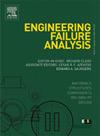Moderate temperature wear behaviour of Magnesium-Dicalcium silicate composite
IF 4.4
2区 工程技术
Q1 ENGINEERING, MECHANICAL
引用次数: 0
Abstract
This study investigates the effect of dicalcium silicate content on the moderate-temperature wear behaviour of magnesium-dicalcium silicate (AZ91D-Ca2SiO4) composites over a temperature range of 100 °C,150 °C, 200 °C and 250 °C. Various wear mechanisms were investigated in AZ91D-Ca2SiO4 composites under specific temperature conditions. AZ91D-Ca2SiO4 composites were fabricated with different weight percentages (2.5 %, 5 %, and 10 %) of Ca2SiO4 reinforcement using the stir casting process. Hardness, phase composition, wear depth, and morphological changes were observed in the composites after wear testing. The metal-oxide interaction regimes were precisely detailed through the tribology characterization. The results demonstrate a significant increase in wear rate as temperatures rise from 100 °C to 250 °C. Specifically, at temperatures around 100 °C and 150 °C, abrasive wear and oxidation were identified as the primary wear mechanisms. At moderate temperatures, around 250 °C, abrasive wear, plastic deformation, and delamination were the dominant wear mechanisms. The higher presence of Mg-Si and Mg-Ca phases, along with Ca2SiO4 particles, on the worn surfaces of the composites has reduced the oxidation of the AZ91D matrix at moderate temperatures. Furthermore, this study reports a detailed investigation into the influence of different weight percentages (2.5 %, 5 %, and 10 %) of Ca2SiO4 on the moderate-temperature wear behaviour of AZ91D and AZ91D-Ca2SiO4 composites.

求助全文
约1分钟内获得全文
求助全文
来源期刊

Engineering Failure Analysis
工程技术-材料科学:表征与测试
CiteScore
7.70
自引率
20.00%
发文量
956
审稿时长
47 days
期刊介绍:
Engineering Failure Analysis publishes research papers describing the analysis of engineering failures and related studies.
Papers relating to the structure, properties and behaviour of engineering materials are encouraged, particularly those which also involve the detailed application of materials parameters to problems in engineering structures, components and design. In addition to the area of materials engineering, the interacting fields of mechanical, manufacturing, aeronautical, civil, chemical, corrosion and design engineering are considered relevant. Activity should be directed at analysing engineering failures and carrying out research to help reduce the incidences of failures and to extend the operating horizons of engineering materials.
Emphasis is placed on the mechanical properties of materials and their behaviour when influenced by structure, process and environment. Metallic, polymeric, ceramic and natural materials are all included and the application of these materials to real engineering situations should be emphasised. The use of a case-study based approach is also encouraged.
Engineering Failure Analysis provides essential reference material and critical feedback into the design process thereby contributing to the prevention of engineering failures in the future. All submissions will be subject to peer review from leading experts in the field.
 求助内容:
求助内容: 应助结果提醒方式:
应助结果提醒方式:


